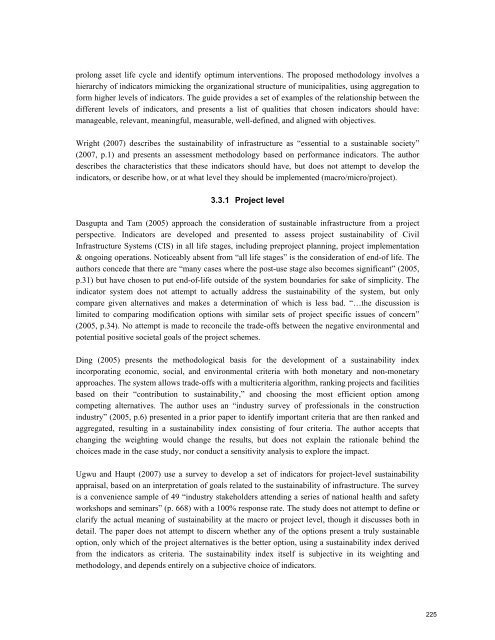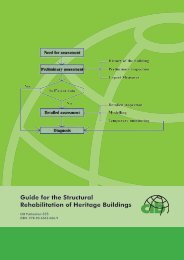CIB W116âSmart and Sustainable Built Environments - Test Input
CIB W116âSmart and Sustainable Built Environments - Test Input
CIB W116âSmart and Sustainable Built Environments - Test Input
You also want an ePaper? Increase the reach of your titles
YUMPU automatically turns print PDFs into web optimized ePapers that Google loves.
prolong asset life cycle <strong>and</strong> identify optimum interventions. The proposed methodology involves a<br />
hierarchy of indicators mimicking the organizational structure of municipalities, using aggregation to<br />
form higher levels of indicators. The guide provides a set of examples of the relationship between the<br />
different levels of indicators, <strong>and</strong> presents a list of qualities that chosen indicators should have:<br />
manageable, relevant, meaningful, measurable, well-defined, <strong>and</strong> aligned with objectives.<br />
Wright (2007) describes the sustainability of infrastructure as “essential to a sustainable society”<br />
(2007, p.1) <strong>and</strong> presents an assessment methodology based on performance indicators. The author<br />
describes the characteristics that these indicators should have, but does not attempt to develop the<br />
indicators, or describe how, or at what level they should be implemented (macro/micro/project).<br />
3.3.1 Project level<br />
Dasgupta <strong>and</strong> Tam (2005) approach the consideration of sustainable infrastructure from a project<br />
perspective. Indicators are developed <strong>and</strong> presented to assess project sustainability of Civil<br />
Infrastructure Systems (CIS) in all life stages, including preproject planning, project implementation<br />
& ongoing operations. Noticeably absent from “all life stages” is the consideration of end-of life. The<br />
authors concede that there are “many cases where the post-use stage also becomes significant” (2005,<br />
p.31) but have chosen to put end-of-life outside of the system boundaries for sake of simplicity. The<br />
indicator system does not attempt to actually address the sustainability of the system, but only<br />
compare given alternatives <strong>and</strong> makes a determination of which is less bad. “…the discussion is<br />
limited to comparing modification options with similar sets of project specific issues of concern”<br />
(2005, p.34). No attempt is made to reconcile the trade-offs between the negative environmental <strong>and</strong><br />
potential positive societal goals of the project schemes.<br />
Ding (2005) presents the methodological basis for the development of a sustainability index<br />
incorporating economic, social, <strong>and</strong> environmental criteria with both monetary <strong>and</strong> non-monetary<br />
approaches. The system allows trade-offs with a multicriteria algorithm, ranking projects <strong>and</strong> facilities<br />
based on their “contribution to sustainability,” <strong>and</strong> choosing the most efficient option among<br />
competing alternatives. The author uses an “industry survey of professionals in the construction<br />
industry” (2005, p.6) presented in a prior paper to identify important criteria that are then ranked <strong>and</strong><br />
aggregated, resulting in a sustainability index consisting of four criteria. The author accepts that<br />
changing the weighting would change the results, but does not explain the rationale behind the<br />
choices made in the case study, nor conduct a sensitivity analysis to explore the impact.<br />
Ugwu <strong>and</strong> Haupt (2007) use a survey to develop a set of indicators for project-level sustainability<br />
appraisal, based on an interpretation of goals related to the sustainability of infrastructure. The survey<br />
is a convenience sample of 49 “industry stakeholders attending a series of national health <strong>and</strong> safety<br />
workshops <strong>and</strong> seminars” (p. 668) with a 100% response rate. The study does not attempt to define or<br />
clarify the actual meaning of sustainability at the macro or project level, though it discusses both in<br />
detail. The paper does not attempt to discern whether any of the options present a truly sustainable<br />
option, only which of the project alternatives is the better option, using a sustainability index derived<br />
from the indicators as criteria. The sustainability index itself is subjective in its weighting <strong>and</strong><br />
methodology, <strong>and</strong> depends entirely on a subjective choice of indicators.<br />
225

















